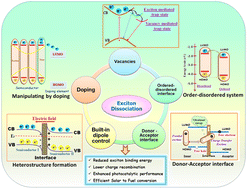Band-structure tunability via the modulation of excitons in semiconductor nanostructures: manifestation in photocatalytic fuel generation
Abstract
Understanding the energetics of electron transfer at the semiconductor interface is crucial for the development of solar harvesting technologies, including photovoltaics, photocatalysis, and solar fuel systems. However, modern artificial photosynthetic materials are not efficient and limited by their fast charge recombination with high binding energy of excitons. Hence, reducing the exciton binding energy can increase the generation of charge carriers, which improve the photocatalytic activities. Extensive research has been dedicated to improving the exciton dissociation efficiency through rational semiconductor design via heteroatom doping, vacancy engineering, the construction of heterostructures, and donor–π–acceptor (D–π–A) interfaces to extend the charge carrier migration, promoting the dissociation of excitons. Consequently, functionalized photocatalysts have demonstrated remarkable photocatalytic performances for solar fuel production under visible light irradiation. This review provides the fundamental aspects of excitons in semiconductor nanostructures, having a high binding energy and ultrafast exciton formation together with promising photo-redox properties for solar to fuel conversion application. In particular, this review highlights the significant role of the excitonic effect in the photocatalytic activity of newly developed functional materials and the underlying mechanistic insight for tuning the performance of nanostructured semiconductor photocatalysts for water splitting, CO2 reduction, and N2 fixation reactions.

- This article is part of the themed collections: Celebrating International Women’s day 2024: Women in Nanoscience and Recent Review Articles


 Please wait while we load your content...
Please wait while we load your content...